Haiti Earthquake: Capitalism, Occupation and Revolution
July 2010
No to Imperialist Occupation – U.S./U.N. Forces Out!
Repeated warnings by geologists that Haiti’s capital of Port-au-Prince was in danger of a devastating earthquake were ignored. Peasants were forced off the land and into precarious slums by U.S. economic policies that destroyed Haiti’s agriculture. Capitalism and imperialism caused the horrendous death toll.
The earthquake that wrecked the capital of Haiti and surrounding areas on January 12 produced human tragedy of almost unfathomable proportions. The numbers are staggering: up to 300,000 bodies picked up on the streets, many dumped in mass graves; perhaps half a million dead when you include those buried by relatives and untold numbers lying under the rubble. In absolute numbers it is far greater than the Asian tsunami of 2004; compared to total population, this is eight times the death toll of the Nicaraguan earthquake of 1972 that destroyed its capital, Managua. The 1912 earthquake that leveled Tokyo produced two-thirds as many fatalities. Most families in the Port-au-Prince area lost close relatives, tens of thousands of children are now without parents. On top of this, hundreds of thousands of dwellings were wiped out: over 2 million people were left homeless, living in overcrowded, unsanitary tent camps and other makeshift shelters. The presidential palace and hillside shantytowns alike were wiped out, virtually every government building collapsed along with the cathedral, 4,228 schools were destroyed. The Inter-American Development Bank “estimates Haiti’s quake is likely to be the most destructive natural disaster in modern times” (New York Times, 17 February).
Five months later, Haiti is no longer in the headlines or on the nightly TV news. The hordes of journalists who descended on the ravaged country to record its agony have left. The aid telethons are over. Haiti is awash with NGOs,1 each branding their projects with their own logo (and squabbling over who gets the most visible sites). Some rubble has been cleared, but for the hard-hit Haitian population the scene has hardly changed. The number of homeless has not decreased. According to a United Nations report, as of June 19 some 1.5 million are living in 1,200 camps (“spontaneous settlement sites” in U.N. bureaucratese) in and around the capital, while another 660,000 “internally displaced persons” (“IDPs”) have sought refuge elsewhere in the country. Since the rains began in April, the camps have turned to mud, leading to a sharp increase in communicable diseases. And with the official start of the hurricane season on June 1, flood waters and lashing winds will soon be washing and blowing away the flimsy tents and tarps along with whatever the earthquake didn’t destroy, potentially causing thousands more deaths. Meteorologists predict 15 to 18 named tropical storms will hit Haiti this summer.
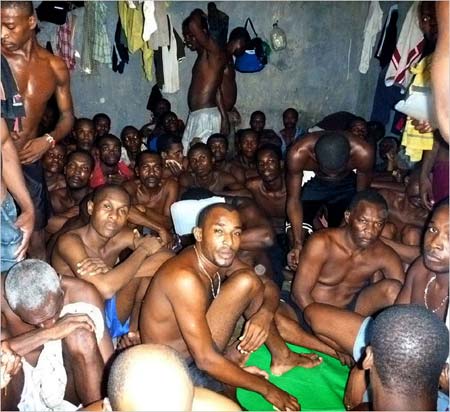
Prisoners in jail at Les Cayes. Police massacre killed as many as 19 inmates. (Photo published by New York Times)
Meanwhile, Haiti is still under imperialist occupation, as it has been ever since the U.S. kidnapped the bourgeois populist president Jean-Bertrand Aristide in March 2004, depositing him in a Central African jungle, and together with France and Canada took over the country. Three months later they subcontracted the occupation to the United Nations, to be policed by a hired “peacekeeping” force, the MINUSTAH, under Brazilian command. With the January 2010 earthquake, the Obama administration figured it could get some good press by invading again, only this time under the cover of “humanitarian aid.” Humvees crawled menacingly through Port-au-Prince with heavily armed U.S. Marines and paratroops, M-16s at the ready to shoot down “looters.” The U.S. has now withdrawn the 82nd Airborne Division and turned over “security” to a beefed-up MINUSTAH. But not entirely: while Joint Task Force Haiti has been dissolved, 500 National Guard troops of Task Force Kout Men (Helping Hands) are stationed outside Gonaïves and in July the USS Iwo Jima will arrive for “Operation Continuing Promise.”
The U.N. mercenary occupation force continues its repression against the Haitian masses. A horrendous massacre took place a week after the earthquake, at a jail in the town of Les Cayes, only coming to light in May. Although the jail was not seriously damaged, nearly 500 hundred inmates were jammed together in tiny cells. When the prisoners tried to escape on January 19, they were surrounded by Haitian National Police (PNH) and MINUSTAH police. After several hours, the Haitian police stormed the jail, executing unarmed prisoners as they lay on the floor. Anywhere from 12 to 19 were murdered. The bodies of the dead and wounded were left “strewn through the courtyard and crumpled inside cells. The prison smoldered, a blood-splattered mess,” according to a report by the New York Times (23 May), which exposed the slaughter. While the U.N. police claim they didn’t shoot anyone, at the very least they let the butchery happen and then covered up the crime. As for the PNH, it was set up and trained by the imperialists and staffed with killers recruited from the death squads of the military dictatorship.
Under the U.S./UN occupation, armed violence against the Haitian masses continues unabated. The day after the massacre at Les Cayes was revealed, Brazilian MINUSTAH troops attacked students at the State University of Haiti, firing rifles as they invaded the school of ethnology and blanketing the surrounding area with tear gas. Clouds of gas choked residents of the huge nearby tent camp on the Champs de Mars, opposite the presidential palace, while a number of the 60,000 residents were wounded by rubber bullets. Ansel Herz of the IPS news agency, who reported the attack, showed photos of U.S.-supplied munitions used by the troops. Naturally, none of this appeared in the “mainstream” imperialist press. What did get covered was the installation of the Haiti Interim Reconstruction Commission (HIRC), headed by Bill Clinton as the new colonial gouverneur, at the luxury resort of Punta Cana in the Dominican Republic. The HIRC is intended to sideline the formal Haitian government of President René Préval and give effective control of “reconstruction” to the imperialist donors (see “U.S. Puts Haiti into Receivership” [April 2010]). Yet not even 1 percent of the money pledged at earlier meetings in Montréal and New York has been received, much less spent.
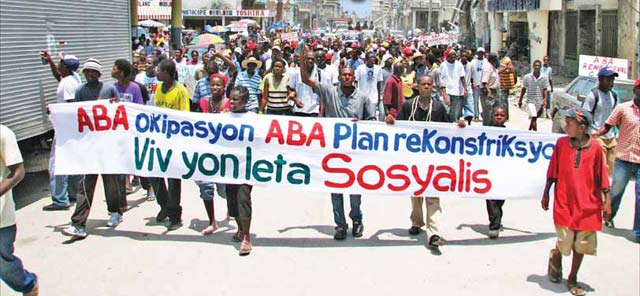
Demonstrators march in Port-au-Prince on June 1, sixth anniversary of the occupation of Haiti by United Nations forces (MINUSTAH) on behalf of U.S. imperialism. Sign says: “Down with the Occupation, Down with the Reconstruction Plan, Long Live a Socialist State.” (Photo: Haïti Liberté)
Contrary to their humanitarian pretensions, the U.S. and U.N. forces are there to ensure Washington’s domination of Haiti and the region. From the dawn of the imperialist era, U.S. rulers have invaded country after country, time after time, to ensure that the Caribbean remains an “American lake.” After occupying Puerto Rico and seizing Cuba in 1898,2 the U.S. (under liberal Democrat Woodrow Wilson) launched an extended occupation of Haiti (1915-34) and the Dominican Republic (1916-1924). With the onset of the anti-Soviet Cold War, the U.S. has made sure that, one way or another, it had firm control of Haiti – under the dictatorship of the Duvalier dynasty (1957-86), under the boot of the military (1986-90, 1991-94), under the government of populist president Jean-Bertrand Aristide (put in power by Bill Clinton and a U.S. expeditionary force in 1994, removed from power a decade later by George Bush II and a U.S. expeditionary force), and since 2004 under a U.N. occupation force. Today, Yankee imperialism still insists on controlling this strategically placed country – just across the Windward Passage from Cuba and within striking distance of Venezuela – even against imperialist allies/rivals such as France.
The Internationalist Group and League for the Fourth International defend Cuba, a bureaucratically deformed workers state, and Venezuela under the bourgeois nationalist-populist Hugo Chávez against U.S. imperialism. We fight for independence of Puerto Rico, a U.S. colony. Unlike many on the left who hesitated to call for U.S. troops out of Haiti when Obama claimed they only were providing aid to earthquake victims (and in sharp opposition to the Spartacist League which grotesquely supported the U.S.’ “humanitarian” invasion3), the IG and LFI have ceaselessly fought to drive U.S./U.N. forces out of Haiti, all in the framework of a struggle for a socialist federation of the Caribbean.
Now a new calamity is looming in Haiti, and like the one last January, the disaster is anything but natural. In its consequences it is, as Guatemalan survivors of an earlier calamity expressed it, a “class quake.” More specifically, the terrible toll of death and destruction and the non-existent reconstruction are the direct consequence of the capitalist social order and imperialist domination of the impoverished Caribbean nation. For more than two centuries, Haiti, the black republic born of a slave revolution, has been condemned to endless misery imposed by the former colonial masters and modern imperialists. Their empires are built on the superprofits extracted from the toilers in the semicolonies – together with exploitation of the proletariat within the imperialist coountries – and their economic and military world domination. What’s needed to escape from this vicious circle is not simply more money to rebuild from the ruins (or to “refound” or “reimagine” Haiti, as the bourgeois politicians are now lyrically proclaiming) but a new Haitian revolution, a region-wide workers revolution that with hurricane force sweeps away capitalism throughout the Antilles and extends to the imperialist metropolis itself.
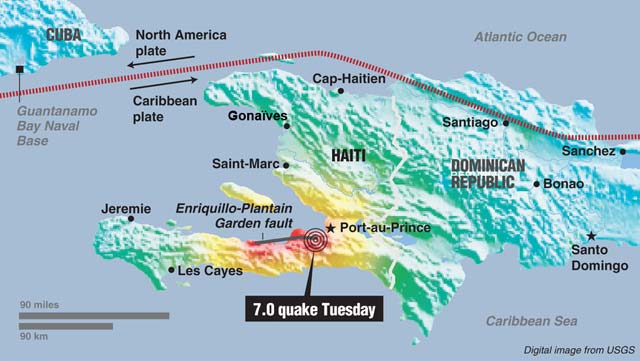
A Catastrophe Made By Capitalism
How was the Haitian earthquake calamity caused by capitalism? Let us count the ways. First, the January 12 quake was entirely predictable, and was predicted, yet no provisions were made to ensure or improve the safety of the population. Second, a quarter million people were killed not by the temblor itself, which killed practically no one, but by collapsing buildings which were not constructed to withstand even a relatively mild quake. Third, the massive carnage was the result of some three million people being jammed into a geologically risky space, largely as a result of economic policies that have ruined Haitian agriculture, forcing peasants into the capital city of Port-au-Prince. Fourth, there was no civil emergency plan to rescue those trapped in the rubble, and no public health and hospital system to care for the survivors. These features are not uniquely Haitian but common to semicolonial capitalist countries under the boot of imperialist world domination.
To begin with, this was a tragedy foretold. Scientists had been warning for some time that an earthquake was likely, precisely where it occurred, on the Enriquillo Fault, which runs from Jamaica through the Haitian capital to the Dominican Republic. Port-au-Prince had suffered a devastating earthquake in November 1751, shortly after it was made capital of the French colony of Saint-Domingue. “Only one masonry building had not collapsed,” according to the French historian Moreau de Saint-Rémy, who wrote: “During these days of anguish, the population lived in tents. Port-au-Prince is transformed into a Bedouin camp” – like today. A second quake occurred in June 1770, completely leveling the small city, destroying government buildings, hospitals, houses. And as Eric Calais, a professor of geophysics at Purdue University (Indiana), emphatically warned at a conference at the State University of Haiti in May 2008: “Where there has been an earthquake before, there will be an earthquake again!” (“Will There Be an Earthquake in Haiti?” in Le Nouvelliste, 21 May 2008). Calais and Paul Mann of the University of Texas had done recent studies showing greatly increased stress on the Enriquillo Fault.
Over the last two years there was extensive discussion in Haiti over the danger of a quake. In December 2008 there was a “Conference-Debate On Earthquakes and Their Consequences”; in March 2009, engineer Claude Prepetit spoke to a meeting of specialists on the subject, “What Will Happen If a New Earthquake Strikes Haiti?” A newspaper report, “The Spectre of a Destructive Earthquake” began: “Demographic growth, anarchic construction and environmental degradation render Haiti even more vulnerable to natural catastrophes” (Le Nouvelliste, 26 March 2009). In October, engineer Prepetit gave another talk, beginning with the warning that seismologists say “Haiti is a high-risk place.” He reported on the liquefaction of the earth in certain areas and pointed to particularly vulnerable slums, showing slides of active faults in the capital area. In December, yet another talk by Prepetit. Le Nouvelliste (17 December) headlined: “Are We Living on a Powder Keg?” Three weeks later the deadliest earthquake of modern times struck, turning Port-au-Prince into a gigantic cemetery.
Construction standards were obviously non-existent in reality. Even buildings housing international agency personnel such as the Hotel Montana or the MINUSTAH headquarters collapsed. Haiti had a building code before the earthquake – all of two pages, which was reportedly used by engineers but not contractors. However, the main concern of builders was not a once-in-200-years earthquake but withstanding the destructive hurricanes which occur several times a year. Thus most housing construction consisted of concrete with steel reinforcing bars, with heavy roofs that pancaked, with particularly deadly effect. Older wooden buildings caused far fewer casualties. Then there was the effect of shoddy construction: rebars were of brittle, rather than ductile, steel, so they snapped rather than bent; they had no ribbing to hold the cement together; the cement was poor quality, with four and five parts sand to one part concrete instead of one-third, etc. As geologist Robert Bilham of the University of Colorado reported after returning from an inspection trip of the Haiti quake zone, buildings in Haiti acted as “weapons of mass destruction” (interview on Democracy Now, 1 March).4
The Haiti quake was not even terribly intense: at 7.0 on the Richter scale it was 1/500 the intensity of the 8.8 magnitude earthquake in Chile a few weeks later in which a little over 500 people died. The inferior construction methods in Haiti reflect the generalized poverty of the country. Even if there had been adequate building codes, few could afford to erect safe constructions. The building practices were also the result of the destruction of Haiti’s industrial capacity by capitalism. A main reason why the use of substandard cement was universal is that Haiti’s only cement plant was privatized in 1996 at the insistence of U.S. economists, and then closed down because it was cheaper to import from Mexico, given the U.S.-ordered reduction in tariffs. Today, with Haiti’s lack of foreign exchange, the result is a permanent shortage of concrete at any price. Meanwhile, the country has a dire lack of engineers, since most educated professionals emigrated to escape from the Duvalier dictatorship and the military junta, and are reluctant to return to a chaotic pseudo-democracy under foreign occupation. Haiti’s engineers live in the Dominican Republic, the U.S., France and Quebec.
Imperialist Devastation of Haiti’s Economy
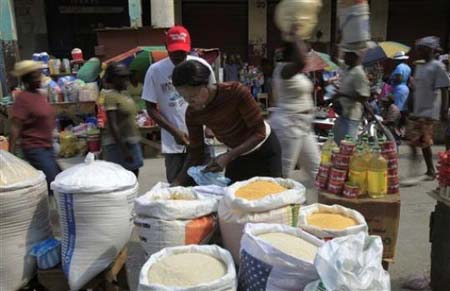
A quarter century of importing heavily subsidized rice from the United States has devastated Haiti’s agriculture. Above: market in Port-au-Prince. (Jorge Saenz/AP)
The destruction of Haiti’s agriculture is likewise the result of conscious policy. The first case was the wholesale slaughter of creole pigs, which were a mainstay of the peasant economy. The reason given was to control the spread of African swine flu (which originated in Spain, then spread to the Dominican Republic). After all 1.2 million of Haiti’s pig population were butchered in 1983 at the insistence of the U.S., USAID said it would replace a fraction with “better” piglets from the U.S. Midwest (at $50 each, a windfall for U.S. hog farmers but nearly impossible to afford for Haitian peasants, with an average annual cash income of around $130). However, “Iowa hogs” were not nearly as hardy, requiring clean water (somethig 60 percent of the Haitian population doesn’t have), imported feed and roofed pigpens with concrete floors. Haitian peasants quickly dubbed them “four-footed princes.” The imported pigs soon died off. A main source of protein disappeared from the Haitian masses’ diet, and peasants had lost their “savings account” (pigs were sold to pay for marriages, schooling, medical emergencies).5
Then came the destruction of Haiti’s sugar and rice industries. In his book Planet of Slums (2006), urban theorist Mike Davis points to Haiti – along with Mexico – as a country where the vast expansion of the slum population in recent years was the result of cheap food imports (under “free trade” agreements, “structural adjustment programs” and bilateral deals with the United States) making local agriculture uncompetitive in the market and pushing ex-peasants to migrate to the cities, or to the U.S.. In 1987, Haiti’s sugar mill was privatized, sold like the cement plant a decade later to the Mervs family, who closed it down in favor of importing cheaper sugar from the Dominican Republic – where it is produced by Haitian workers toiling in near-slavery. That put an end to Haiti’s sugar industry (3,500 workers, 40,000 peasant growers). Next on the chopping block was rice farming. In the 1970s, Haiti exported rice. But in the early ’90s, the Democratic administration of Bill Clinton demanded that Haiti eliminate tariffs on rice in exchange for the U.S. lifting duties on Haitian citrus exports.
U.S. experts were perfectly aware of the consequences. A 1995 USAID report assessing Haiti’s potential for agribusiness wrote:
“An export-driven trade and investment policy has the potential to relentlessly squeeze the domestic rice farmer. This farmer will be forced to adapt, or (s)he will disappear.”
–quoted in Lisa McGowan, “Democracy Undermined, Economic Justice Denied: Structural Adjustment and the Aid Juggernaut in Haiti” [January 1997]).6
That is exactly what happened. Soon Haiti, the poorest country in the Western Hemisphere, was the fourth-largest importer of (heavily subsidized) rice from the U.S. Dubbed “Miami rice” by the peasants, it mostly came from Clinton’s home state of Arkansas. The disastrous results of these policies were driven home by the April-May 2008 food crisis in Haiti, when millions faced starvation and many were reduced to eating “cakes” made of mud and straw. Now, following the earthquake, Bill Clinton made a dramatic self-criticism, saying “we made this devil’s bargain on rice.” “It may have been good for some of my farmers in Arkansas,” Clinton said to the Senate Foreign Relations Committee, “but it has not worked.” (see Democracy Now, 1 April). The ex-president added that he has to “live every day with the consequences of the lost capacity to produce a rice crop in Haiti to feed those people, because of what I did. Nobody else.”
No show of contrition can absolve Bill Clinton from the responsibility of producing a massive food crisis, destroying the livelihoods of hundreds of thousands of Haitian peasants, and forcing them to move into the swollen Port-au-Prince slums where many died in the earthquake. And now he’s back at it, this time pushing Coca-Cola’s mango scheme (see below) and a “development model” of Rwanda – the Central African country where Clinton’s protégé, Tutsi leader Paul Kagame, sparked a genocide that killed hundreds of thousands of Tutsis and Hutus.7 Yet it wasn’t just Clinton, and it wasn’t just the policy of “neo-liberalism.” Haiti was no paradise for peasants and workers under the 29-year dictatorship of the Duvaliers when “import substitution” was all the rage among economists. Haiti then had high import duties and nationalized sugar milling, flour milling, cement, telephone and electricity companies ... which were sources of graft for the ruling kleptocracy. Switching to another “development model” won’t solve Haiti’s food supply problems, make the countryside flourish or bring about rationally planned urban development. The capitalist system itself must be swept aside along with the debris from the earthquake.
“It’s to me completely unacceptable that we should live in a world where you can shake the ground a little bit, and the buildings will fall down,” said geologist Robert Bilham. “We know how to do it right.” Yes, but this knowledge must be put to use, and that depends on the social order. It should be equally unacceptable to live in a world of mass hunger and unemployment which produce the precarious slums that become death traps in the face of “class quakes,” hurricanes, tsunamis, landslides and other “natural” calamities. Haiti is an abundant tropical island and while there are certain things it can’t produce (like fodder for milk cows), it can certainly feed itself and export agricultural produce it is now constrained by the world market to import. Deaths from post-hurricane flooding can be greatly reduced by river control and drainage, but who will pay for this? Reforestation will take some time, but how to avoid pirate loggers cutting down the forests again? Industrial production can provide a road out of poverty, but not with sweatshop wages and conditions.
Geologist Bilham calculates that “earthquake-proof reconstruction in Haiti is likely to cost an order of magnitude [ten times] more than has been promised so far, even using local materials and local manpower.” So long as Haiti remains a poverty-wracked capitalist semi-colony, the many tens of billions of dollars necessary to build infrastructure, public buildings and housing will not be forthcoming. Haiti will be like Nicaragua, a country where almost four decades after the earth trembled, the lasting devastation is a constant reminder of the need for international socialist revolution.
For Haitian-Dominican Workers Revolution in a Socialist Federation of the Caribbean
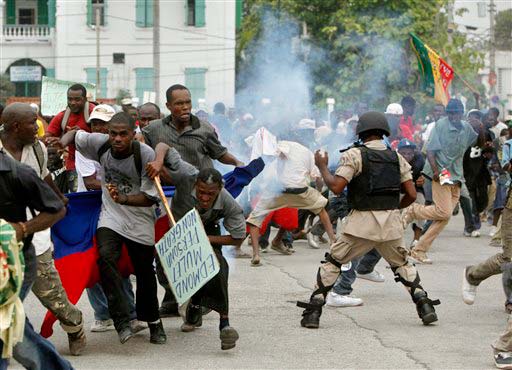
Demonstrators protesting against Préval government and presence of U.N. occupation forces flee tear gas barrage by MINUSTAH troops. (Photo: Esteban Félix/AP)
So the Haitian earthquake and its horrendous consequences were predictable, and were predicted – but nothing was done about it. The devastating effects of U.S.-imposed economic policies on the Haitian economy were likewise predictable, and predicted – but with slight modifications, the same policies underlie the imperialists’ plans for capitalist “reconstruction” of Haiti. It will take a revolutionary mobilization of the Haitian workers, peasants and poor people to put an end to the endless tragedies that have plagued the land of Toussaint Louverture, the “black Spartacus” who led the revolution that abolished slavery and threw off French colonial rule. With the bankruptcy of the rickety Haitian capitalist state glaringly obvious in the aftermath of the January 2010 earthquake, there is a patent need to overturn the bankrupt social order. What’s key is an internationalist program, for Haitian and Dominican workers to join hands in overthrowing their capitalist rulers on the island of Quisqueya (Hispaniola) and to overcome the colonial legacy that carved up the region, through a socialist federation of the Caribbean and a joint struggle together with North American workers to smash imperialism.
In recent weeks, there have been a number of protest demonstrations by diverse political forces. On May 10 and 17, several thousand demonstrators of the bourgeois opposition bloc demanded Préval’s departure. This bloc brings together the Fanmi Lavalas, supporters of the ousted president Aristide, and the Alyans grouping headed by Evans Paul, one of the leaders of the right-wing opposition to Aristide in 2004. On May 24, the Agence Haïtienne de Presse headlined, “Rock throwing, burning barricades and great panic in the center of the capital,” as MINUSTAH “peacekeepers” attacked students protesting against the Préval government and the HIRC. On May 25 and 27, the bourgeois opposition was back in the streets. On June 1 several hundred marched on the sixth anniversary of the MINUSTAH occupation of Haiti, demanding U.N. troops out and that Préval resign as president; a lead banner read, “Down with the Occupation, Down with the Reconstruction Plan, Long Live a Socialist State!” On June 4, there was the demonstration by tens of thousands of peasants against Monsanto in the town of Hinché; and on June 8, a protest of several dozen mainly Lavalas supporters outside the Brazilian embassy. Again, none of these were reported in the imperialist press.
So even though the entire country was traumatized by the devastation of the quake and the 1.5 million people left homeless in Port-au-Prince, Leogâne and nearby towns are consumed by the daily struggle to survive, protests have not stopped – though so far they are mainly by a politically active minority. It is notable that the targets of the bourgeois opposition are Préval and Prime Minister Jean-Max Bellerive, not the U.S. and the HIRC headed by Bill Clinton. And they have spared the NGOs and aid agencies, even though there has been virtually no construction of structures to provide shelter against storms. Some “left” sectors in the splintered Lavalas milieu, such as the weekly Haïti-Liberté, criticize the “restavèk” bourgeoisie, comparing the country’s current figurehead rulers to children consigned to slave labor. It’s right to point to the utter dependence of both Préval & Co. and bourgeois opposition groups such as those around Charles Henry Baker and other sweatshop capitalists on the U.S. But Lavalas itself is and has always been a bourgeois political movement. What these “leftists” are yearning for is an more robust, independent bourgeoisie, not a revolution.
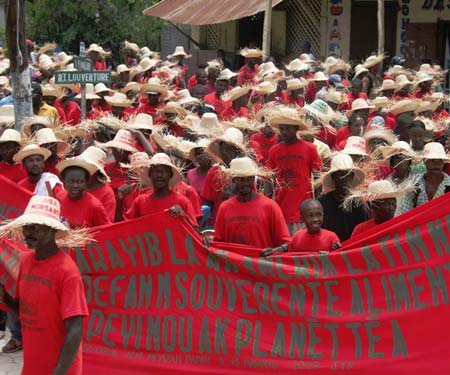
Peasants demonstrate against Monsanto, Hinche, June 4. (Photo: Alice Speri)
Other leftists, such as Marc Arthur Fils Aimé, director of the Karl Lévèsque Cultural Institute and spokesman for the Inisyativ Pati Kan Pèp La (Initiative for a Party of the People’s Camp), have noted the fundamental identity of the government and the opposition, noting that the protests by the latter do not seek to “question the nature of the current system,” that they “never say they want a state that will stop this government from selling off the people’s property, that would carry out an agrarian reform,” etc. The Inisyativ defines itself as “a Marxist, Leninist political organization,” but with its demands and by its self-definition as representing the “people’s camp,” it indicates that it is seeking reforms within the framework of capitalism. Similarly, the syndicalist organization Batay Ouvriye (Workers Struggle) in a statement “After the January 12, 2010 Earthquake” (7 February) declares that “we must work to reinforce the progressive camp both inside and abroad (in the belly of the beast). We must reinforce the people’s camp” which “can only happen through the leadership of working people.”
Since the time of the French Revolution, “the people” has stood for a conglomeration of classes including the bourgeoisie, as opposed to the aristocracy, monarchy, etc. The “people’s fronts” or popular fronts of the 1930s and their continuations such as Salvador Allende’s Popular Unity (UP) in Chile in the 1970s are class-collaborationist alliances intended to chain the workers to a supposedly “progressive” section of the capitalist class. But in the imperialist epoch, there can be no independent, progressive or national bourgeoisie capable of carrying out revolutionary democratic tasks in the semi-colonial countries. The minuscule local ruling classes are dependent on domestic reaction and on imperialism in order to maintain their exploitation of the vast mass of workers, peasants and poor. Even with the addition of a few words about “working-class leadership,” any “alliance” with bourgeois sectors, however tiny, in a “people’s camp” or popular front will restrict the struggle to the limits of capitalism. And from Spain in the 1930s to Indonesia in 1965 to Chile in the ’70s, that always spells defeat for the proletariat.
The slogan of Allende’s UP, “the people united will never be defeated” is a lie – it’s rather the opposite: so long as the toilers are tied to a sector of the exploiters in the name of “the people,” capital will triumph. Victory for the wave slaves against their masters depends on breaking with the bourgeoisie and fighting for power to the workers leading all the oppressed in a revolutionary class struggle.
Haitian leftists who see themselves as Marxists all look back to Jacques Roumain, the founder of the Haitian Communist Party in the early 1930s. In his Analyse schématique 32-34, Roumain trenchantly analyzed the fraud of bourgeois nationalism:
“The great majority of the working class now understands the lies of bourgeois nationalism. More and more, it closely ties the notion of anti-imperialist struggle with that of the class struggle; more and more it becomes aware that fighting imperialism is to fight capitalism, foreign or indigenous, it means an all-out fight against the Haitian bourgeoisie and the bourgeois politicians, the valets (servants) of imperialism and cruel exploiters of the workers and peasants.”

Jacques Roumain, founder of the Haitian Communist Party (Photo: CIDIHCA Archives)
But while clearly seeing the reactionary nature of the bourgeois nationalists, Roumain did not draw the vital conclusion that the working class must seize power, backed by the peasants and poor, and institute its own class rule. And with his references to the “National Proletariat,” he obscured the need to fight for the victory of the international proletariat. Roumain’s essay was written in 1934, at a time when the official Communist parties following the “general line” laid down by Stalin in the Kremlin were on a bureaucratic centrist, at times even ultra-leftist, course. But soon after, the Stalinists went over to the popular front and sought alliances with the very “national bourgeoisie” that Roumain had so sharply excoriated.
Leon Trotsky, co-leader together with V.I. Lenin of the Bolshevik October Revolution, summed up the lessons of the Russian 1905 and 1917 revolutions in his theory of permanent revolution. Precisely because of the inability of the bourgeoisie in late-developing capitalist countries to carry out the democratic tasks of the classical bourgeois revolutions, he concluded, “the victory of the democratic revolution is conceivable only through the dictatorship of the proletariat which bases itself upon the alliance with the peasantry.” Moreover, once in power, led by their communist party, the workers will soon be required to infringe on the rights of bourgeois property: “The democratic revolution grows over directly into the socialist revolution,” which while it begins on national terrain must be extended internationally in order to survive. This is doubly true in a small, impoverished semi-colonial country like Haiti facing the most powerful imperialism in history. But Haitian workers have an important trump card: they are present not only in the periphery but in the heart of international finance capital.
It is necessary to promote the self-organization of the poor and working people in a fight against the capitalist system and imperialist domination – a class struggle for power. Above all, this requires building the nucleus of a Leninist vanguard party of the working class as part of the struggle to reforge the Trotskyist Fourth International.
A transitional program is necessary leading from today’s struggles to socialist revolution, beginning with the fight against imperialist occupation. The League for the Fourth International demands: MINUSTAH and U.S. forces get out of Haiti! A communist nucleus in Haiti would oppose the state of emergency under which Préval/Bellerive have prolonged their terms and the “Interim Reconstruction Commission” has supplanted the Haitian government. It would call for elected committees in the camps to take charge of relief and, seizing well-suited land (in consultation with geologists and engineers) no matter who claims it as their property, to begin constructing urgently needed housing. It would call for hard-hitting mobilizations to massively unionize export industries, not shop by shop but all together. And in this country where 85 percent of the schools are private and half the adult population cannot read and write, educators, students, workers and parents together with university students and faculty can begin organizing public schools near the camps, turning them into community centers for literacy training.
In this country where the formal economy has been devastated by rapacious capitalists, domestic despots and their imperialist patrons long before the earthquake, the Haitian proletariat is relatively small – but it can lead the masses of urban and rural poor in a struggle against capital. And while as a result of the endless disasters besetting the island nation, a large part of the population has emigrated, the dispersal of Haitian workers can be turned to advantage. Next door in the Dominican Republic, Haitian workers in the sugar fields and construction industry can be a link to Dominican fellow workers, laying the basis for mutual defense against racist victimization and government attacks. In Brazil, our comrades of the Liga Quarta-Internacionalista do Brasil have waged a successful fight to win education workers to struggle for the expulsion of Brazilian troops from Haiti. And in Canada and the U.S., notably the cities of Montréal and New York, hundreds of thousands of Haitian working people can be a bridge to North American workers in common struggle against imperialism. ■
1 Non-Governmental Organizations, which are mostly fronts for governments, foundations and international agencies. There were an estimated 10,000-plus present in Haiti before the earthquake, making it the highest NGO/population ratio in the world, and there are more now. The reason for the large number of NGOs is the refusal of the U.S. and U.N. to send aid through the Haitian government, instead funneling it through these private groups.
2 After imposing the Pratt Amendment to the Cuban constitution, giving the U.S. unlimited rights to intervene militarily, U.S. troops landed in Cuba again in 1906, 1912 and 1917, as well as Honduras (1907, 1911), Panama (1908, 1918, 1925), Nicaragua (1909, 1910) and the Mexican port of Veracruz (1914). By World War I, the western Caribbean was ringed with U.S.-occupied countries and puppet regimes.
3 See, “Spartacist League Backs U.S. Imperialist Invasion of Haiti” (30 January), “SL Twists and Turns on Haiti” (9 April) and (after the SL did an about-turn and ignominiously withdrew its support) “Open Letter from the Internationalist Group to the Spartacist League and ICL” (8 May).
4 Bilham notes that no one should have been surprised by the January 12 earthquake since “Most islands in the northern and eastern Caribbean owe their existence to seismic processes on or near the edges of the Caribbean Plate.” Moreover, he warns (as have other geologists) of the danger of a new earthquake in the same area around Port-au-Prince, since “adjacent segments of the fault to the east and west of the recent subsurface rupture are now near breaking point because of stress transferred to them.” Even at the epicenter of the recent quake, the surface was not broken, indicating the possibility of a new temblor in the very same place (Nature, 18 February).
5 See the Grassroots International video, narrated by Pulitzer Prize winning Haitian American author Edwidge Danticat, Haiti’s Piggy Bank: The Story of the Loss and Recovery of Haiti’s Creole Pig, available at: http://video.google.com/videoplay?docid=2407538368251439007&hl=en#
6 See also Laurie Richardson, Feeding Dependency, Starving Democracy: USAID Policies in Haiti (Grassroots International, May 1997).
7 We have written of Kagame’s outfit, the Rwanda Patriotic Front, that “the RPF itself carried out massive killings of Hutus,” which is contrary to the standard U.S. account that there was a one-sided genocide against Tutsis by Hutus (see “Kabila Army's Genocidal Mass Murder of Rwandan Hutu Refugees,” The Internationalist No. 3, September-October 1997). Kagame, an English-speaking Rwandan exile who had been head of military intelligence in the Ugandan armed forces, was trained at the U.S. Army Command and Staff College. More recently, considerable evidence has come to light of RPF actions that touched off the genocide.
See also: Capitalist “Reconstruction” of Haiti
To contact the Internationalist Group and the League for the Fourth International, send e-mail to: internationalistgroup@msn.com
Get Involved
If you'd like to help with maintaining or developing the website, contact us.
Publish
Publish your stories and upcoming events on Indybay.


